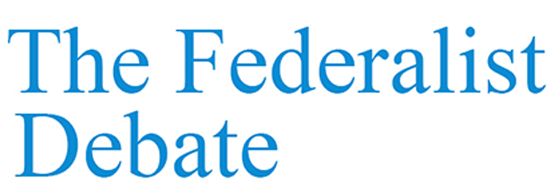Year XXXVII, Number 1, March 2024
Is Federalism Inevitable?
Jean-François Drevet
Former civil servant in the European Commission, specialist in regional development issues
The paper is divided in three Chapters, the first of which is published here, while the others will be published in the next issues of the review. (Ed.'s Note)
Faced with the multiplication of crises, what assessment can we make of the recent developments in the European construction? Here we present an analysis of the prospects for the emergence of federalism in the European Union in three chapters:
- The lesson of history: polities only become federal by obligation. The evolution of the European Union (EU) towards a federalist construction is not without precedent. The experiences of the United States, Australia and Switzerland show that bottom-up progression is possible, but that it encounters a lot of resistance and takes time, despite acceleration phases in exceptional circumstances.
- When will the transition in the EU end? Several years of crisis have shown the shortcomings of European governance, both at the level of each government taken individually, and through their joint action or inaction within the framework of the Council, where it has several times proven impossible to make the general European interest prevail. However, a number of converging signs have emerged in recent years, in particular the “Next Generation EU” recovery plan.
- Towards a federalist shift? As long as it was only a question of dealing with economic affairs, the EU could move forward through compromises, for which there was all the necessary time. This is no longer possible. For several reasons (internal and external), the long-awaited qualitative leap has become an emergency.
Chapter 1. The lesson of history: polities only become federal by obligation
Despite the increasing seriousness of the events that have occurred since 2008, on economic and monetary crisis comparable to the “Great Depression” of the 1930s, Brexit, and then the Covid pandemic and finally in February 2022, the outbreak of an open war in Ukraine, the European Union has not collapsed. And converging signals, notably the implementation of the Next Generation EU recovery plan, the joint purchase of Covid vaccines and its coordinated support for Ukraine have shown that progress in European integration is still possible.
In the 1960s, people believed that the common market would be the stepping stone for an integrated Europe; but the EEC at the time did not manage to cross the red line of the transition to a political union. More recently, the creation of the single market, then the euro, were supposed to make the implementation of a federal management of the economies inevitable. However, and despite other transformations, notably the Great Enlargement of 2004-2007, which made it even more necessary, such a qualitative leap has not been achieved.
It must be recognized that a “bottom up” process, where the constituent parties agree to delegate a significant part of their powers to a higher level of government, is not self-activating. Where this goal has been achieved, the creation of a federal state has been preceded by more or less long transitions, lasting sometimes several decades, where the disadvantages and inadequacies of confederal-type organizations have been demonstrated. The analysis of such periods reveals many similarities with the current problems of the EU.
Among the twenty federations in operation today, we will discuss here the experiences which preceded their establishment in three countries: the United States, Australia and Switzerland.
In the United States, after the failure of confederalism.
Before adopting the Constitution of 1787, people sometimes forget that the thirteen American colonies had lived between 1774 and 1789 under a confederal regime, formalized by the Continental Congress in the form of “The Articles of Confederation”, which were legally in force from 1781 to 1789. It was a text intended to give Congress the minimum of powers necessary to lead the war of independence. The Confederation had some weaknesses of the current EU, in particular the delays in ratifications (it took three years for the Articles to come into force, due to Maryland’s whims):
- a) a lack of fiscal power: Congress could issue paper money, and take out loans, but it could not raise taxes directly. It depended therefore on the contributions from States, which would lead them to ruin, due to the heavy expenses of the war. (Until 2020, the European Commission could not run into debt and it no longer had real own resources);
- b) it had no power to levy customs duties, which deprived it of significant resources and prevented it from signing trade treaties with other countries. (The Commission has this competence, but the abolition of customs has deprived it of notable revenues);
- c) a lack of direct representativeness: the members of Congress are only representatives of their state, they follow imparted instructions and voting is done by state (as in the European Council);
- d) the Articles could only be modified by a vote of Congress and the ratification by all the States was necessary (which is the case of the increasingly laborious revisions of the European treaties).
All these disadvantages are the basis of the changes introduced by the Philadelphia Convention and explain the transition to the federal regime established by the Constitution of 1787, still in force. The problem for European federalists is that the EU cannot get out of this intermediate phase and build the United States of Europe that they want. The Federalist Papers, written by Hamilton and Madison to conter the objections of the opponents to the American Constitution, were mentioned in recent institutional negotiations[i] , but the European Convention of 2002-2003 did not obtain the results of the Convention of Philadelphia. The problem is still topical, but although Brexit has put an end to British obstructions, the EU member states are reluctant to re-engage in a process that has delivered slow and weak results.
In Australia, thanks to the effectiveness of the tax weapon
In Australia, as previously in Canada, it was not just a matter of transferring upwards the competences previously exercised at the level of each of the colonies. The federation was also to receive part of the powers exercised by the center, in this case the British government and the Westminster Parliament. In fact, the problems did not come from that side, but from the former colonies, which became States by analogy with the United States. At the end of the 19th century, “in a territory as vast as the United States, five territorial districts[ii] were playing the role of sovereign powers. Separated by customs barriers, using railways of different sizes, not collecting the same types of 20 taxes, each having their own postal system, even different postage stamps, managing without consideration for the others the essential problems of education, of social legislation, of public works, having constituted weak armed forces between which no coordination existed, they cut a poor figure compared to the Canadian provinces which, despite their differences of origin, of language, of religion, had succeeded since 1867 in setting up a form of union[iii] ”(in fact a Federation). It had long been clear that a Federation was necessary, but it did not materialize until 1901, due to strong internal rivalries. Then, the compromise accepted on that date left a large part of the powers in the hands of the States, because the powers of the Commonwealth (the Australian federal level) had been defined by “Section 51” of the Constitution in restrictive terms.
This did not prevent the government in Canberra from increasing its prerogatives well beyond what had initially been envisaged. As the amendments to the Constitution were subject to a double majority vote of the population and the States (as is the case today in the European Council, provided that it is not a matter requiring a unanimous decision), they refrained from carrying out revisions (only two have been carried out since 1901). De facto, the Commonwealth broadened its powers by extending its fiscal powers:
- initially its fiscal weight was small: during the first decade of the federation, although it benefited from the proceeds of customs duties and excises, it only spent a quarter of it and returned the balance to the States;
- owing to the needs created by the two world wars, it gradually acquired preponderance by increasing its fiscal resources: the Commonwealth’s share of revenue increased from 13% (1901) to 73% in 1918, • to consolidate its position, the federal government first reduced the borrowing capacity of the States in 1927 (the Maastricht criteria ahead of its time), then in 1942 assumed the exclusive power to tax income in order to cope with the necessities of the war and the threat of a Japanese invasion;
- this development was made necessary by an excessive tax competition between States and by their budgetary difficulties. It was facilitated by their divisions: the two largest states (Victoria and New South Wales) were in constant rivalry, and the less populated ones were in opposition to the two previous ones, therefore favorable to the extension of federal power, of which they were net beneficiaries (like today the Member States having priority in the Community structural funds);
- the fiscal monopoly allowed Canberra to impose its priorities on the States, forced to request subsidies from the federal power to carry out their policies, including in areas where they had in principle retained exclusive competence;
- as in Europe, this development was favored by the Court of Justice (High Court in Australia) which most often supported the Commonwealth in its interpretation of the Constitution, against the recriminations by the States.
Since 1970, the process has been reversed by a “devolution” movement that has returned part of the taxing power to the states. However, the Commonwealth’s share remains high (82% of revenues in 2000) and the States are still dependent on Canberra for 40% of what they receive (the subsidies are conditional, like the European structural funds). Despite the application of the principle of subsidiarity (often invoked in Europe), the government in Canberra retains a large margin of action. Thus, Australia offers the example of a federation based on a fairly restricted legal framework, where the federal power was able to impose itself by a budgetary spill over. This peculiarity is not the only explanation, but shows that significant development is possible without incurring costly revisions of the legal framework. This is what the EU did with the single market, but without achieving comparable results, due to the limits to the community budget and the ban on borrowing.
In Switzerland, federalizing the confederation
In Europe, federalism is most often linked to the Germanic tradition. Austria attests to the permanence of very ancient autonomous territorial units, from the composite Habsburg monarchy to the nation state restored in 1955. As for Germany, it has long had a confederal organization: the Holy Roman Empire, then the Germanic Confederation which replaced it after 1815. From 1871, it has been governed by a federal system (with the exception of the Nazi period from 1933 to 1945), robust enough to be maintained after the defeats of the two world wars, and has risen to the challenge of unification since 1990.
But the case that comes closest to the European experience is Switzerland, due to the slowness and prudence of the construction of its federal framework.
In order not to go back too far in history, we will limit ourselves to the Confederation of 1815. If the territorial organization is close to the current one[iv], each canton has retained its legislation, its currency, its postal systems, its army and its flag. The federal pact is such only in name, since there is no real central authority. The Diet is a simple conference of cantonal ambassadors, each having one vote and deliberating on instructions (like the current COREPER, committee of permanent representatives in Brussels). A two-year rotating presidency is exercised by one of the three “directing cantons” (Zurich, Bern and Lucerne) and no modification of the pact can be made without unanimous agreement of the cantons (as with the European treaties). Neighboring states are very keen on this rule to keep Switzerland powerless.
The Confederation pays the price for such a defective organization: multiple pressures from neighboring countries are exerted on a Diet reduced to impotence by the incessant disputes between the cantons. From 1840, “reinforced cooperations” in the form of leagues between a few cantons jeopardized the unity of the whole.
In 1845-1848, Switzerland was threatened with a civil war by the secessionist movement of the Sonderbund, which had to be reduced by military intervention (a small war of secession lasting 26 days which left around a hundred dead), but it knew how to draw the consequences.
The Constitution of 1848[v] was adopted by a majority, as had been required by the cantons of the Sonderbund at the time of their submission. Switzerland retained its official name of Confederation, but in reality became a federal state. The central government received exclusive competence to deal with foreign countries, to control customs (disappearance of internal tolls, freedom of settlement throughout the Swiss territory), defense, currency and the postal system[vi]. Two councils (the National Council and the Council of States) were to adopt the legislation in co-decision, a collegial government of 7 members to execute it and a federal court to arbitrate disputes.
Thus, about thirty years had been necessary to move from an organization partly comparable to the current European Union, to a federation sufficiently structured to maintain the Swiss identity, while respecting its linguistic and religious diversity. In the face of the rise of nationalism in the second half of the 19th century (German and Italian unifications) and the two world wars in the 20th, which could Comments have dislocated the federation, this is a fairly good result. Would the 27 or 30 EU member states be ready to follow the way paved by the 26 Swiss cantons?
[i] Larry Siedentop, Democracy in Europe, Allen Lane, Penguin Press, London, 2000, 254p. Siedentop takes inspiration from the American example, even though he is not a federalist.
[ii] Six really: New South Wales, Victoria, Queensland, Western Australia, South Australia and Tasmania.
[iii] Robert Lacour Gayet, Histoire de l’Australie, Fayard, Paris, 1973, 558p.
[iv] Switzerland widened in 1848 with Neuchatel, and a 26th canton, the Jura, was created in 1978.
[v] Revised in 1874, 1891, 1999, in particular for enhancing popular initiatives.
[vi] Also public transport, the appointment of judges of the Federal Court, the control of certain basic insurances, such as AVS (compulsory pension fund), unemployment and disability insurance.




